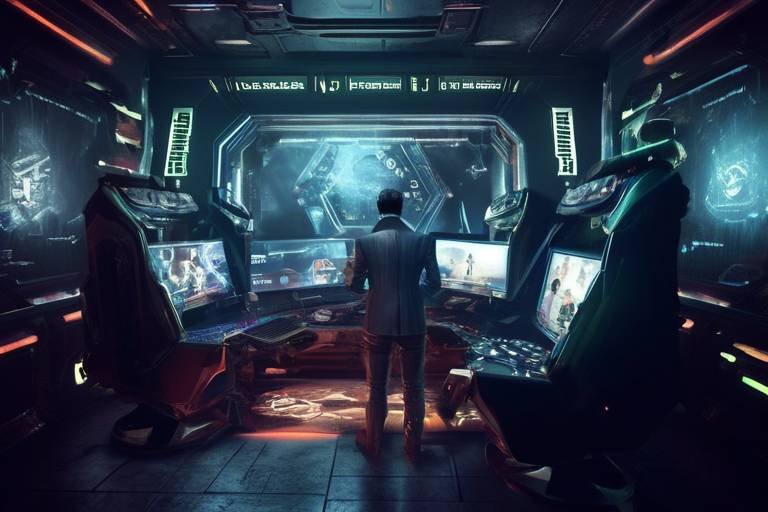Future of Gaming: Role of AI in Game Development
The world of gaming is undergoing a seismic shift, and at the heart of this transformation is artificial intelligence (AI). As technology continues to evolve, AI is becoming an indispensable tool in game development, reshaping how games are designed, developed, and experienced. Imagine stepping into a game where the environment reacts to your every move, where the storyline adapts based on your choices, and where every interaction feels genuinely unique. This is not just a fantasy anymore; it's the future of gaming, powered by AI.
In recent years, developers have begun to harness the power of AI to create immersive experiences that were once thought impossible. With AI, game worlds are no longer static; they are dynamic, evolving landscapes that respond to player actions in real-time. This capability not only enhances the overall player experience but also allows for a level of personalization that was previously unattainable. Think about it: how cool would it be to play a game that learns your preferences and adjusts itself accordingly? That's the kind of magic AI brings to the table.
As we delve deeper into the role of AI in game development, it's essential to recognize its multifaceted applications. From procedural content generation to dynamic difficulty adjustment, AI is streamlining production processes and enhancing player engagement. Developers are now able to create vast, intricate worlds filled with unique assets that evolve with each playthrough, making every gaming session feel fresh and exciting.
Moreover, AI is not just about creating engaging gameplay; it's also about improving the development process itself. With AI-driven tools, developers can automate tedious tasks like game testing and quality assurance, allowing them to focus on the creative aspects of game design. This not only speeds up the production timeline but also ensures a higher quality product upon release. Imagine a world where bugs are identified and fixed before players even encounter them—this is the promise of AI in game development.
In the coming sections, we will explore specific applications of AI in gaming, including how it enhances non-player character (NPC) behavior, personalizes gameplay experiences, and even enriches storytelling. The future of gaming is bright, and AI is leading the charge, transforming how we interact with digital worlds. So, buckle up as we dive into this exciting journey!
- What is AI's role in game development? AI helps in creating dynamic environments, personalizing gameplay, and automating testing processes.
- How does procedural content generation work? It uses algorithms to generate game content, making each playthrough unique.
- Can AI improve NPC behavior? Yes, AI enhances NPCs by making them more responsive and realistic, improving player engagement.
- What are the benefits of AI in multiplayer gaming? AI can balance matchmaking and ensure fair competition, leading to a better gaming experience.

AI-Driven Game Design
Artificial intelligence is revolutionizing game design in ways that were once the stuff of science fiction. Imagine a world where games adapt to your play style, where the story unfolds differently based on your choices, and where every encounter feels fresh and exciting. This is not just a dream; it's the reality that AI is helping to create. With AI, developers can craft immersive worlds that respond to players in real-time, creating a dynamic narrative that feels personal and engaging.
One of the most significant advantages of AI-driven game design is its ability to analyze player behavior. By tracking how players interact with the game, AI can adjust elements like difficulty, pacing, and even storyline paths, ensuring that each player has a unique experience tailored just for them. This level of personalization not only enhances player satisfaction but also keeps them coming back for more. After all, who doesn’t want a game that feels like it was made just for them?
To better understand the impact of AI on game design, let's consider a few key applications:
- Dynamic Environments: AI can create environments that change based on player actions, making the game world feel alive and reactive.
- Personalized Narratives: By leveraging player choices, AI can guide the storyline in different directions, offering multiple endings and pathways.
- Enhanced Character Interactions: AI can enable characters to respond in human-like ways, making conversations more engaging and realistic.
Moreover, AI can assist in procedural content generation, where algorithms create vast and diverse game landscapes and assets on the fly. This not only reduces development time and costs but also ensures that players encounter unique experiences every time they play. Imagine exploring a new world with each session, where no two adventures are the same!
As we look to the future, the potential for AI in game design seems limitless. Developers are continuously exploring new ways to incorporate AI into their projects, pushing the boundaries of what games can be. With advancements in machine learning and data analysis, we can expect even more sophisticated AI applications that will further enhance player engagement and satisfaction.
In conclusion, AI-driven game design is not just a trend; it's a transformative force that is reshaping the gaming landscape. As technology continues to evolve, we can only imagine the exciting possibilities that lie ahead. Are you ready to step into a world where every game is uniquely yours?

Procedural Content Generation
Procedural content generation (PCG) is one of the most exciting advancements in the realm of game development, driven by the capabilities of artificial intelligence. Imagine stepping into a game world where every corner you turn reveals something new and unexpected, where no two playthroughs are ever the same. This is the magic of PCG, where algorithms create vast, diverse environments and assets on-the-fly, making the gaming experience infinitely more engaging and dynamic.
By utilizing AI algorithms, developers can significantly reduce development time and costs while simultaneously enriching the player experience. The beauty of procedural generation lies in its ability to produce complex landscapes, intricate dungeons, and unique quests without requiring an army of artists and designers. For instance, a game could generate a sprawling forest filled with different types of trees, wildlife, and hidden treasures each time a player enters, ensuring that exploration never feels stale.
Here are some key benefits of procedural content generation:
- Endless Variety: Players can explore new environments each time they play, keeping the experience fresh and exciting.
- Resource Efficiency: Developers can allocate resources more effectively, focusing on core gameplay mechanics rather than endlessly crafting content.
- Enhanced Replayability: The unpredictable nature of procedurally generated content encourages players to return, eager to discover what new adventures await.
Moreover, PCG isn't limited to just landscapes or levels; it can also be applied to character creation, item generation, and even quest design. Think of it as a chef who can whip up a new dish every time they step into the kitchen. This not only saves time but also allows for a greater breadth of creativity, as developers can experiment with different algorithms to see what unique experiences they can concoct.
However, while procedural content generation offers numerous advantages, it also presents some challenges. For instance, ensuring that the generated content is coherent and maintains a high level of quality can be tricky. Developers must strike a balance between randomness and structure to create an immersive experience that feels intentional rather than chaotic. This is where AI's role becomes even more critical, as it can help refine and curate the generated content, ensuring that it aligns with the game's overall vision.
In summary, procedural content generation is transforming the landscape of game development, allowing for a level of creativity and variety that was previously unimaginable. As AI continues to evolve, we can expect even more innovative applications of PCG, making the future of gaming not just brighter, but also more exciting than ever before.
Q1: What is procedural content generation?
A1: Procedural content generation is a method used in game development where algorithms create game content dynamically, allowing for unique experiences in each playthrough.
Q2: How does procedural content generation save time and resources?
A2: By automating the creation of environments, assets, and quests, developers can focus on core gameplay elements rather than manually designing every aspect of the game.
Q3: Can procedural content generation be used in all types of games?
A3: While it is particularly popular in open-world and sandbox games, procedural content generation can be adapted for various genres, including RPGs and platformers.
Q4: Are there any downsides to procedural content generation?
A4: Yes, one challenge is ensuring that the generated content is coherent and maintains quality. Developers must carefully balance randomness with structure to create a seamless experience.

Dynamic Difficulty Adjustment
Dynamic Difficulty Adjustment (DDA) is a groundbreaking feature in modern gaming that leverages the power of artificial intelligence to tailor the gaming experience in real-time. Imagine you're playing your favorite game, and suddenly, the difficulty shifts seamlessly to match your skill level. This isn't just a dream; it's the reality that AI brings to the table. By analyzing your performance, DDA can modify aspects of the game, ensuring that you remain challenged yet not overwhelmed. This balance is crucial, as it keeps players engaged and motivated to continue their journey.
One of the most fascinating aspects of DDA is how it can adapt to various player styles. For instance, if you're a seasoned gamer who breezes through levels, the AI can increase the difficulty by introducing tougher enemies or more complex puzzles. Conversely, if you're struggling, it can ease the pressure by providing additional resources or reducing enemy strength. This dynamic adjustment creates a personalized experience that feels tailor-made just for you, enhancing your overall enjoyment.
To illustrate how DDA works, consider the following table that highlights the key elements involved in this adaptive mechanism:
| Player Performance | DDA Response |
|---|---|
| High Skill Level | Increase enemy difficulty, add time constraints |
| Moderate Skill Level | Maintain current difficulty, introduce new challenges |
| Low Skill Level | Decrease enemy strength, provide additional resources |
The beauty of DDA lies in its ability to create an experience that feels both rewarding and fair. Players often find themselves immersed in a game that respects their skills and challenges them at the right moments. Imagine playing a racing game where the AI adjusts the speed of your opponents based on how well you're performing. If you're nailing every turn and zooming ahead, the AI might speed up the competition to keep things exciting. But if you're lagging behind, it could slow down the others just enough to give you a fighting chance. This kind of intelligent design not only enhances player satisfaction but also fosters a deeper connection to the game.
Furthermore, DDA has significant implications for game developers as well. By implementing AI-driven difficulty adjustments, developers can cater to a broader audience. This means that both casual gamers and hardcore enthusiasts can find joy in the same title, leading to a more inclusive gaming community. It’s a win-win situation where players feel challenged yet supported, and developers can reach a wider market.
In conclusion, Dynamic Difficulty Adjustment is not just a technical feature; it’s a game-changer that enhances player experience and engagement. As AI continues to evolve, we can expect even more sophisticated methods of tailoring gameplay to individual preferences, ensuring that every player’s journey is unique and satisfying.
- What is Dynamic Difficulty Adjustment? - It is a feature that uses AI to modify game difficulty in real-time based on the player's performance.
- How does DDA improve the gaming experience? - By ensuring that players are neither overwhelmed nor bored, maintaining engagement and satisfaction.
- Can DDA be used in multiplayer games? - Yes, DDA can be applied in multiplayer settings to balance competition among players of varying skill levels.
- Are all games using DDA? - No, not all games implement DDA, but its adoption is increasing as developers recognize its benefits.

Personalized Gameplay Experiences
Imagine stepping into a game world that feels like it was tailor-made just for you. are becoming a reality, thanks to the incredible advancements in artificial intelligence. By analyzing a player's behavior, preferences, and even their emotional responses, AI can create a gaming environment that adapts in real-time. This means that every decision you make can influence the game in a way that feels unique and engaging.
For instance, consider how your favorite game might change based on your choices. If you're the type who loves to explore every nook and cranny, AI can recognize this and reward you with hidden quests or unique items that cater to your adventurous spirit. On the flip side, if you prefer a more straightforward path, the game can adjust to provide a more streamlined experience. This level of customization not only enhances player satisfaction but also increases the time spent in-game, as players are more likely to return to a game that feels personal to them.
Moreover, AI can analyze player data to fine-tune various gameplay elements, such as:
- Character Development: Characters can evolve based on your interactions, making them feel more alive and relatable.
- In-Game Challenges: AI can introduce challenges that align with your skill level, ensuring a perfect balance between difficulty and enjoyment.
- Story Arcs: The narrative can shift to reflect your choices, making each playthrough a fresh experience.
As technology continues to advance, the potential for even deeper personalization is on the horizon. Imagine a game that not only remembers your past choices but also predicts your future ones based on patterns in your gameplay. This could lead to experiences that are not just reactive but also proactively engaging, creating an immersive world that feels alive.
In conclusion, the integration of AI in creating personalized gameplay experiences is not just a trend; it’s a revolution in how we interact with games. It’s about crafting a journey that resonates with each player on an individual level, making every moment spent in the game worthwhile and memorable.
- How does AI personalize my gaming experience? AI analyzes your gameplay patterns and preferences to adjust game elements, making the experience unique to you.
- Will personalized experiences make the game easier? Not necessarily. AI aims to balance difficulty according to your skill level, enhancing engagement without sacrificing challenge.
- Can AI predict my choices? As technology advances, AI can potentially analyze your gameplay to anticipate your choices, leading to a more immersive experience.

Adaptive Storytelling
Imagine diving into a game where the story isn’t just a linear path, but a vibrant tapestry that weaves itself around your choices. is the magic behind this phenomenon, allowing narratives to evolve based on player decisions. This technology transforms the gaming experience from a passive journey into an interactive adventure, where every choice can lead to a different outcome. It’s like being the author of your own story, where the plot twists and turns according to your actions.
At its core, adaptive storytelling leverages artificial intelligence to analyze player behavior and preferences. This means that the game can adjust the storyline in real-time, creating a unique experience for each player. For instance, if you choose to ally with a particular character, the game might alter the narrative to reflect that alliance, introducing new quests or challenges that wouldn’t exist if you had made a different choice. This level of personalization makes players feel more connected to the game world, as their decisions have real consequences.
Consider a game where you are a hero in a fantastical realm. You might face a choice: save a village from a dragon or pursue a hidden treasure. Your decision not only affects the immediate outcome but can also ripple through the game, altering relationships with other characters, unlocking new quests, or even changing the game’s ending. This is the essence of adaptive storytelling—it creates a living, breathing world that reacts to your every move.
Moreover, adaptive storytelling encourages exploration. Players are more likely to revisit the game to experience different story arcs. This replayability factor is crucial in keeping players engaged long after the initial playthrough. After all, who wouldn’t want to see how a different choice could have changed the fate of their character? The thrill of discovery, combined with the emotional weight of your decisions, makes adaptive storytelling a powerful tool in modern game design.
To further illustrate the impact of adaptive storytelling, let’s look at a few key benefits:
- Increased Player Engagement: Players are more invested in a story that reflects their choices, leading to deeper emotional connections.
- Enhanced Replayability: With multiple outcomes based on different decisions, players are encouraged to replay the game to explore all possibilities.
- Dynamic Game Worlds: The narrative shifts create a more immersive experience, making the game world feel alive and responsive.
In conclusion, adaptive storytelling is not just a trend; it’s a revolutionary approach to game design that reshapes how players interact with narratives. As AI technology continues to advance, we can expect even more sophisticated storytelling techniques that will further enhance our gaming experiences. So, the next time you pick up a controller, remember that the story you’re living is uniquely yours, crafted by the choices you make and the paths you choose to follow.
- What is adaptive storytelling in games? Adaptive storytelling refers to a game design technique where the narrative evolves based on the player's choices, creating a personalized experience.
- How does AI contribute to adaptive storytelling? AI analyzes player decisions and behaviors to adjust the storyline in real-time, allowing for dynamic plot developments.
- Can adaptive storytelling increase a game's replay value? Yes, because players are encouraged to replay the game to explore different choices and outcomes.
- Are there any games that utilize adaptive storytelling? Many modern RPGs and narrative-driven games, such as "The Witcher" series or "Detroit: Become Human," showcase adaptive storytelling effectively.

Game Testing and Quality Assurance
In the fast-paced world of game development, quality assurance (QA) is crucial for delivering a polished product. Traditional methods of game testing often involve extensive manual labor, which can be time-consuming and prone to human error. However, with the advent of artificial intelligence, the landscape of game testing is undergoing a significant transformation. AI tools are now capable of automating various testing processes, which not only enhances efficiency but also improves the overall quality of the game.
Imagine a scenario where a game is tested by a team of dedicated human testers. They meticulously play through every level, searching for bugs and performance issues. Now, envision an AI-driven system that can analyze the game’s code, simulate player behavior, and identify glitches in real-time. This is the power of AI in game testing—it's like having a supercharged assistant that never gets tired and can work around the clock!
AI-driven testing tools can run thousands of iterations in a fraction of the time it would take human testers. They can quickly identify common issues such as crashes, graphical glitches, and performance bottlenecks. This rapid feedback loop allows developers to address issues early in the production process, significantly reducing the time to market. Moreover, these tools can learn from previous testing sessions, continually improving their ability to detect new bugs and anomalies.
One of the most exciting aspects of AI in QA is its ability to simulate human behavior. By analyzing player data, AI can replicate various play styles and strategies, providing developers with insights into how different players might interact with the game. This allows for a more comprehensive testing approach, ensuring that the game is not only functional but also enjoyable for a diverse audience.
To further illustrate the impact of AI on game testing, consider the following table that highlights the key benefits:
| Benefit | Description |
|---|---|
| Speed | AI can conduct tests much faster than human testers, allowing for quicker iterations. |
| Accuracy | Automated testing reduces the likelihood of human error, ensuring more reliable results. |
| Cost-Effectiveness | By streamlining the testing process, AI can help reduce overall development costs. |
| Player Behavior Simulation | AI can mimic various player styles, providing insights that enhance game design. |
In conclusion, the integration of AI into game testing and quality assurance is revolutionizing the industry. By automating tedious tasks and providing deeper insights into player interactions, developers can focus on what truly matters—creating engaging and immersive gaming experiences. As AI technology continues to evolve, we can expect even more innovative solutions that will further enhance the quality and enjoyment of our favorite games.
- What is the role of AI in game testing? AI automates testing processes, identifying bugs and performance issues more efficiently than human testers.
- How does AI improve game quality? By providing rapid feedback and simulating player behavior, AI helps developers address issues early, resulting in a smoother gaming experience.
- Can AI replace human testers? While AI can significantly enhance testing processes, human testers are still essential for providing creative insights and understanding player experiences.
- What are the future trends in AI game testing? We can expect advancements in machine learning algorithms that will allow for even more sophisticated testing methods and player behavior analysis.

Enhancing NPC Behavior
Artificial intelligence is not just about flashy graphics or complex algorithms; it's about breathing life into the digital characters we interact with in games. One of the most exciting advancements in gaming today is how AI is enhancing non-player character (NPC) behavior. Imagine walking into a bustling medieval town in a fantasy game, where every NPC reacts to your presence as if you were part of their world. This level of immersion is made possible by AI, which allows NPCs to exhibit behaviors that are not only realistic but also responsive to player actions.
Gone are the days when NPCs were mere background decorations, following simple scripts and routines. With the integration of AI, these characters can now engage in complex interactions, making them feel more like real people. For instance, an NPC might react differently based on your past interactions. If you've helped them in a quest, they might offer you a special item or express gratitude, whereas if you've wronged them, they might be hostile or refuse to speak to you. This dynamic behavior creates a more immersive gaming experience, as players feel their choices truly matter.
Moreover, incorporating emotional intelligence into NPCs is a game-changer. Developers are now programming NPCs to recognize and respond to player emotions, which can significantly enhance storytelling. For example, if a player approaches an NPC after a significant battle, the NPC might display concern or admiration, reacting in a way that resonates with the player's recent experiences. This emotional depth not only enriches the narrative but also fosters deeper connections between players and characters.
To illustrate the impact of AI on NPC behavior, consider the following table that compares traditional NPC behavior with AI-enhanced NPC behavior:
| Aspect | Traditional NPC Behavior | AI-Enhanced NPC Behavior |
|---|---|---|
| Reactivity | Fixed responses based on scripts | Dynamic responses based on player actions |
| Emotion | Lacks emotional depth | Recognizes and responds to player emotions |
| Interaction | Simple dialogues | Complex, branching dialogues influenced by player choices |
| World Integration | Static, background presence | Active participants in the game world |
In multiplayer experiences, AI also plays a pivotal role in enhancing NPC behavior. Imagine a scenario where NPCs are used as teammates or opponents in a multiplayer game. AI can ensure that these characters adapt to the strategies employed by human players, providing a challenging and enjoyable experience for everyone involved. This adaptability not only keeps the gameplay fresh but also encourages players to develop new strategies, knowing that their opponents—be they human or NPC—are learning and evolving.
In conclusion, the enhancement of NPC behavior through AI is revolutionizing the gaming landscape. By creating emotionally intelligent characters that respond dynamically to player actions, developers are crafting more engaging and believable game worlds. As players, we can look forward to experiencing richer narratives and deeper connections with the characters we encounter, transforming the way we interact with games forever.
- What is the role of AI in NPC behavior? AI allows NPCs to react dynamically to player actions, creating a more immersive and engaging experience.
- How does emotional intelligence enhance NPC interactions? By programming NPCs to recognize and respond to player emotions, the interactions become more meaningful and relatable.
- Can AI improve multiplayer experiences? Yes, AI can adapt NPC behaviors in multiplayer settings, providing a challenging and enjoyable environment for all players.

Emotionally Intelligent NPCs
Imagine stepping into a game world where the non-player characters (NPCs) aren't just mindless bots, but rather, they react to your actions and decisions with a depth of understanding that feels almost human. This is the promise of , a groundbreaking development in game design that leverages artificial intelligence to create characters that can genuinely respond to players' emotional cues.
Traditionally, NPCs operated on a set of predetermined scripts, following a rigid pattern of behavior that often led to repetitive interactions. However, with advancements in AI, developers are now able to incorporate emotional intelligence into these characters, allowing them to interpret player actions and respond accordingly. For instance, if a player chooses to help an NPC in distress, that character might express gratitude, while an NPC who feels threatened may react with fear or aggression. This level of responsive behavior not only enhances the realism of the game but also fosters a deeper emotional connection between players and the game world.
But how do developers achieve this feat? By utilizing complex algorithms that analyze player behavior and emotional states, developers can create NPCs that learn and evolve over time. These characters can take into account a variety of factors, such as:
- Player choices and actions
- In-game events and their outcomes
- Player interactions with other characters
This dynamic interaction model allows NPCs to adapt their responses based on the player's history, making each encounter unique. For example, if a player consistently chooses to act kindly, NPCs may start to trust them more, leading to richer storylines and improved gameplay experiences.
Moreover, emotionally intelligent NPCs can significantly enhance the storytelling aspect of games. By responding in a way that reflects their own personalities and emotions, these characters can create a more engaging narrative. Players might find themselves more invested in the story when they know that their choices genuinely affect the characters around them. This leads to a more immersive experience, where players feel like their actions have real consequences in the game world.
In summary, the integration of emotional intelligence in NPCs represents a significant leap forward in game design. It transforms the gaming experience from a simple interaction to a complex emotional journey, allowing for deeper connections and more meaningful gameplay. As technology continues to evolve, we can expect to see even more sophisticated NPC behaviors, making our gaming worlds feel alive and responsive like never before.
- What are emotionally intelligent NPCs?
Emotionally intelligent NPCs are characters in video games that can respond to player actions and emotions in a realistic manner, creating a more immersive experience. - How do NPCs learn from players?
NPCs use AI algorithms to analyze player behavior and adapt their responses based on previous interactions, leading to a unique gameplay experience for each player. - Why are emotionally intelligent NPCs important?
They enhance the realism of the game, foster deeper player connections, and contribute to more engaging storytelling.

AI in Multiplayer Experiences
In the dynamic realm of multiplayer gaming, artificial intelligence has emerged as a game-changer, significantly enhancing the overall player experience. Imagine stepping into a virtual battlefield where every match feels fresh and exciting, thanks to intelligent matchmaking systems that analyze player skills, preferences, and even play styles. This is not just a dream; it’s a reality made possible by AI. The technology works tirelessly behind the scenes, ensuring that players are matched with opponents of similar skill levels, which leads to a more balanced and competitive environment.
But the role of AI doesn’t stop at matchmaking. It also plays a crucial part in maintaining the integrity of the game. By employing advanced algorithms, AI can monitor in-game behavior to detect cheating or toxic conduct, ensuring that the gaming community remains healthy and enjoyable for everyone involved. For instance, if a player is consistently exhibiting unfair advantages or unsportsmanlike behavior, AI can flag this activity for further review, thereby protecting the integrity of the game.
Moreover, AI can enhance the social aspects of multiplayer gaming. Think about how it can analyze player interactions and suggest friends or teams that align with your gaming style. This level of personalization not only fosters community but also enriches the gaming experience. Players can form alliances or join clans that suit their preferences, creating a sense of belonging and camaraderie.
One of the most exciting advancements in AI for multiplayer experiences is the development of intelligent NPCs that can interact with players in real-time. These NPCs can adapt their behavior based on the actions of players, making the game world feel alive and responsive. For example, if a player is known for being particularly aggressive, an NPC might react with caution or seek to negotiate rather than engage in combat. This level of sophistication adds layers of strategy and realism to the gameplay, making every encounter unique.
To summarize the multifaceted role of AI in enhancing multiplayer experiences, consider the following key benefits:
- Intelligent Matchmaking: Ensures players are matched with others of similar skill levels for fair competition.
- Behavior Monitoring: Detects and addresses cheating and toxic behavior to maintain a positive gaming environment.
- Social Connectivity: Suggests friends and teams based on player interactions and styles.
- Responsive NPCs: Creates a more immersive experience through intelligent non-player characters.
As we look to the future, it’s clear that AI will continue to shape multiplayer gaming in profound ways. The technology is not just about enhancing gameplay; it’s about creating a rich, engaging, and fair environment where players can thrive. With AI at the helm, the possibilities are endless, making every multiplayer experience not just a game, but a journey filled with surprises and challenges that keep players coming back for more.
Q1: How does AI improve matchmaking in multiplayer games?
A1: AI analyzes player skills, preferences, and play styles to match players with others of similar abilities, ensuring a balanced and competitive gaming environment.
Q2: Can AI detect cheating in multiplayer games?
A2: Yes, AI employs advanced algorithms to monitor in-game behavior, flagging any suspicious activity for further investigation to maintain a fair gaming experience.
Q3: How does AI enhance player interactions in multiplayer settings?
A3: AI can analyze interactions and suggest friends or teams that align with a player's gaming style, fostering community and enhancing the overall experience.
Q4: What role do NPCs play in multiplayer gaming with AI?
A4: AI-driven NPCs can interact with players in real-time, adapting their behavior based on player actions, which adds depth and realism to the game world.
Frequently Asked Questions
- How is AI transforming game development?
AI is revolutionizing game development by enabling the creation of more immersive worlds and dynamic narratives. It allows developers to design personalized gaming experiences that adapt to player behavior and preferences, making games more engaging and enjoyable.
- What is procedural content generation?
Procedural content generation uses AI algorithms to automatically create vast and diverse game environments and assets. This approach not only reduces development time and costs but also ensures that players encounter unique experiences with each playthrough, keeping the gameplay fresh and exciting.
- How does AI enhance NPC behavior?
AI enhances non-player character (NPC) behavior by making them more realistic and responsive to player actions. This results in a more engaging and believable game world, where NPCs can react authentically, fostering deeper connections between players and characters.
- What is dynamic difficulty adjustment?
Dynamic difficulty adjustment is a feature powered by AI that analyzes player performance in real-time. It can modify the game's difficulty level to ensure a balanced experience, keeping players engaged without causing frustration or boredom, ultimately enhancing their overall satisfaction.
- Can AI personalize gameplay experiences?
Absolutely! By leveraging player data, AI can tailor gameplay elements to individual preferences. This personalization creates a unique gaming experience for each player, increasing the likelihood of longer engagement with the game and making each session feel special.
- What role does AI play in game testing?
AI tools can automate the game testing process, efficiently identifying bugs and performance issues that may not be easily spotted by human testers. This improves game quality and reduces the time it takes to bring a game to market, ensuring a smoother launch for developers.
- How does AI contribute to multiplayer experiences?
In multiplayer games, AI plays a crucial role in balancing experiences by managing matchmaking and ensuring fair competition among players. This leads to more enjoyable and satisfying gameplay for all participants, allowing everyone to have a good time.
- What are emotionally intelligent NPCs?
Emotionally intelligent NPCs are characters designed to react authentically to player interactions, incorporating emotional responses into their behavior. This enriches the storytelling experience and fosters deeper connections, making players feel more invested in the game.



















